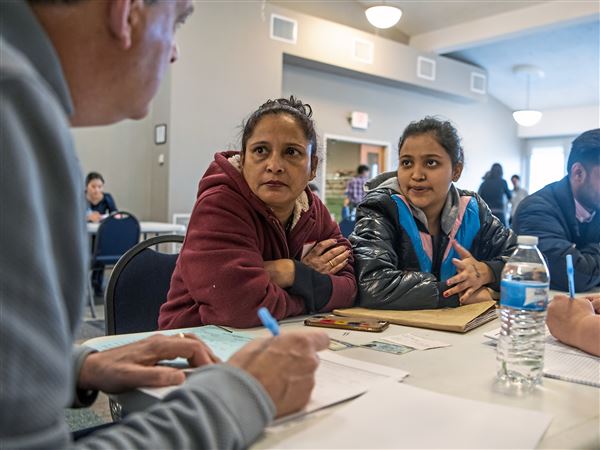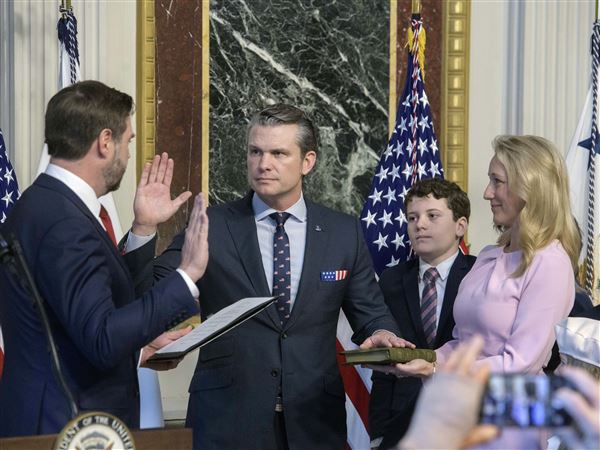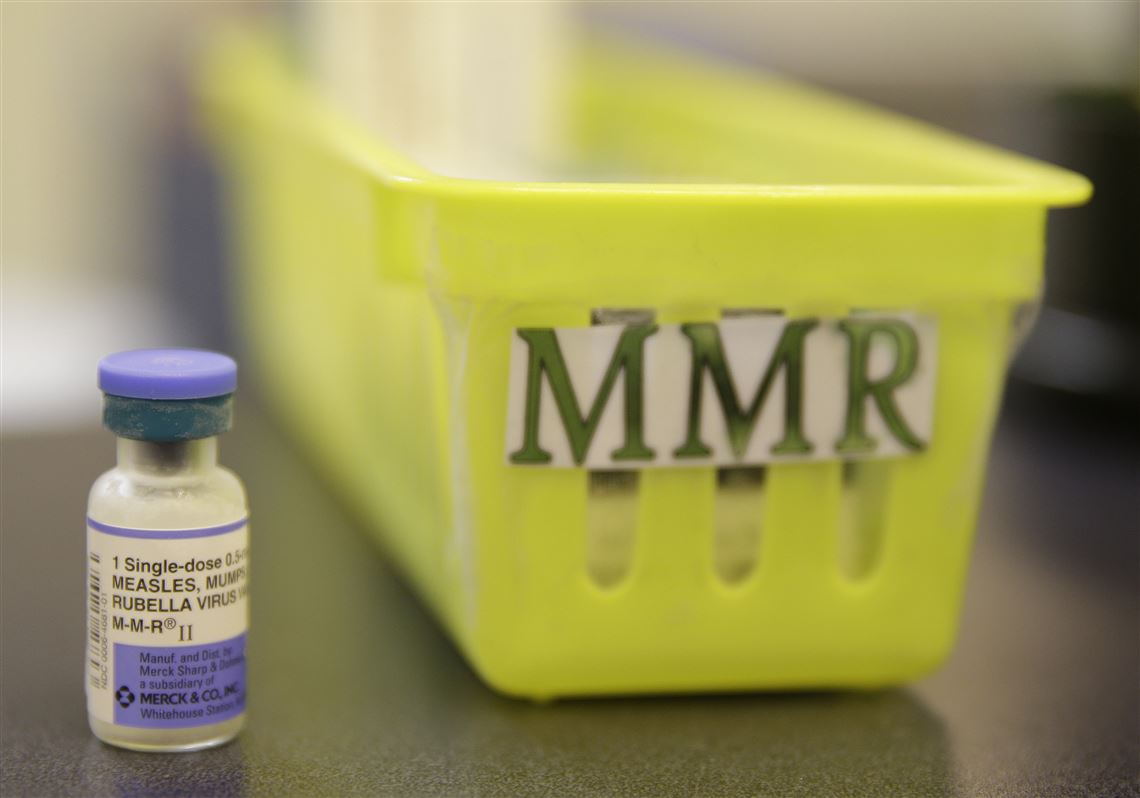Following a November outbreak of the measles virus in Columbus, Ohio, just three hours away, some Pittsburgh-area physicians expressed concern that the virus could travel eastward. And they said a changing vaccine landscape post-pandemic could put children at risk.
Measles is a highly contagious virus that causes fever, cold symptoms and a characteristic rash on the body. The disease is so transmissible that a child can be infected after entering a room even two hours after someone contagious has left it.
Measles was eradicated in the U.S. in 2000, but some outbreaks have occurred since — mainly among unvaccinated populations.
The Columbus Public Health Department announced on Monday that the outbreak had ended. Of the 85 cases, 80 had not been vaccinated. Four had received one of the two doses of the measles, mumps and rubella (MMR) vaccine. All of those infected were minors and, of the 36 hospitalized, the majority were under the age of 3. No deaths were reported.
The Columbus health commissioner, Dr. Mysheika W. Roberts said the outbreak could be traced to June, when four families separately traveled to measles-endemic countries without being vaccinated. On Nov. 9, the health department announced the outbreak in a childcare center.
In a recent interview, she said the city’s goal was to make it two 21-day incubation periods without a measles case so it could declare the outbreak over, which it did on Feb. 6.
During the outbreak, the health department worked hard to educate the public about the benefits of vaccination, Dr. Roberts said, both on social media and via schools and pediatricians.
That seemed to have worked: Dr. Roberts said uptake for the MMR vaccine rose in December. But misinformation about the vaccine is still circulating, which she said was likely the culprit for previous low MMR vaccine uptake.
“I don’t think vaccine fatigue from COVID had anything to do with it,” she said. “Parents chose not to vaccinate against MMR specifically. The children had all their other vaccinations.”
The Centers for Disease Control and Prevention recommends that kids get their first MMR dose at 12 to 15 months of age, and their second dose at 4 to 6 years. And unlike COVID-19, a virus mutating so quickly that shots need to be updated to keep pace with changing variants, the MMR vaccine seems to provide lifelong immunity.
'One of the most infectious diseases'
One way epidemiologists measure the communicability of viruses is by examining the number of people likely to get infected from exposure to one infected person, called an R-naught. This value helps public health experts understand how transmissible a disease is.
The R-naught of the influenza virus is 1.4 — meaning that 1.4 people could be expected to get the flu from one infected person. For COVID, depending on which variants are circulating, it’s between 1.6 and 5. And the R-naught of measles? 12–18.
“Measles is truly one of the most infectious diseases there is,” said Dr. Mark Roberts, a distinguished professor of health policy and management and the director of the Public Health Dynamics Lab at the University of Pittsburgh School of Public Health. “People also don’t remember that measles is not just getting a rash. In other parts of the world, it kills 1 in 1,000 kids.”
In countries with less vaccine uptake, measles still leads to 134,000 deaths every year.
Herd immunity, the idea that widespread vaccination against a pathogen proffers protection for a community, must strike a delicate balance and maintain a certain threshold to work. Dr. Mark Roberts and his team at the Public Health Dynamics Lab created a model from census data to illustrate how many people in a given city or county will be infected with measles based on the vaccination rate of that area.
The model, called FRED Measles, puts two vaccine uptake conditions side by side. (Technically it stands for A Framework for Reconstructing Epidemiological Dynamics, but his colleague suggested it was dedicated to Fred Rogers, because it helps keep neighborhoods safe.) When the model is run for Pittsburgh, two hypothetical disease spreads play out: one if Allegheny County remained at 95% vaccination rate for measles, the other if that rate had dropped to 80%. This side-by-side comparison finds the 80% immunity modeling quickly covered in red as the virus blankets the county with tens of thousands of measles cases, while the 95% scenario holds steady at about 20 cases.
“The sad thing about this is it’s not just your own child you put at risk,” said Dr. Mark Roberts. “You put other kids at risk, too.”
His team was inspired to make the model after the 2014 measles outbreak at Disneyland. Around that time, California state Sen. Richard Pan, a physician, was working on legislation that would make it more difficult for parents to opt out of vaccinating their school-age children due to personal reasons. Sen. Pan showed it to each senator in Sacramento, and they watched that looming red cover their county. Dr. Mark Roberts said some politicians told him later: “It was that University of Pittsburgh simulation that convinced me to support the legislation.”
"There was something about showing a movie of your hometown that people relate to," said Donald Burke, a distinguished professor of health science and policy and epidemiology and a member of Pitt’s Public Health Dynamics Lab.
The MMR vaccine
For the 2021–2022 school year, Allegheny County K–12 was at 95.3% immunity for all required shots. Dr. Mark Roberts said this is a good sign, but the percentage has dropped: In 2015, it was 96.7%.
“Before the widespread availability of vaccines, these diseases had significant impact on the health of children and communities, some resulting in death of children. The fact that these diseases no longer impact our daily lives is due to vaccines,” then-Allegheny County Health Department director Dr. Debra Bogen said in a 2022 news release. “Unfortunately, due to a decrease in vaccination rates across the county, we are seeing preventable diseases, such as polio, reemerge. We must not allow these diseases back into our lives when we have the tools to prevent them.”
Whether measles infiltrates our community depends upon the number of vaccinated kids, and the rates at which kids are vaccinated vary between different types of schools. Private and charter schools tend to have lower vaccination rates than their public counterparts. Data from the Allegheny County Health Department shows the charter school vaccination rate has dropped 2.5% since 2015, the private school vaccination rate 1.2% and public school 1.5%.
Pennsylvania is one of 15 states that allows philosophical exemptions for vaccination, including personal and moral beliefs, according to a 2022 brief from the National Conference of State Legislature.
For Raymond Pitetti, head of the emergency department at UPMC Children’s Hospital, vaccine hesitancy following the Columbus measles outbreak is “a major problem.”
He said he has drafted a letter to his colleagues about the signs and symptoms of measles and how to encourage patients to vaccinate their children against it if they have not already. “To my knowledge, there’s no measles yet in our community,” he said.
To some extent, vaccines are victims of their own success. Many families today have not seen the toll of diseases like polio and smallpox because vaccines have eradicated them. “Vaccines have worked so well for a lot of diseases that people forget what those diseases are actually like,” said Dr. Pitetti.
The MMR vaccine prevented 23.2 million deaths from 2000–2018, according to the CDC, but it has been a target of scrutiny from people who oppose vaccines. This skepticism can be traced to a retracted 1998 paper by the since-discredited doctor Andrew Wakefield, and numerous colleagues, that fraudulently claimed a correlation between the MMR vaccine and autism. The paper and its data have been debunked multiple times by scientists who could not replicate the results. An investigation later revealed that the authors fabricated their findings and were guilty of scientific and ethical violations, deliberate fraud and conflicts of interest.
But this myth spread, and it held on. Beth Hoffman, a postdoctoral associate in the Department of Behavioral and Community Health Sciences at Pitt School of Public Health, said that while those on the extreme end of vaccine opposition only make up about 3% of the population, they are a loud, vocal minority. “They’re really good at tailoring their messaging to parental concern,” seeking out hesitant mothers and capitalizing on their fear, she said.
Social media has exacerbated this, allowing the “disinformation dozen” — a select group of vaccine-opposers in charge of most of the conspiracy momentum, namely Del Bigtree and Robert F. Kennedy Jr. — to be even louder and to target certain groups through more direct channels like Facebook groups.
The health provider's role
“Health care providers and public health professionals need to do a better job at listening to the concerns of patients and tailoring their messaging,” said Ms. Hoffman. “They need to recognize that many of these people are victims themselves of targeted disinformation … They’re just trying to make the best health care decision.”
In a 2019 study, Ms. Hoffman and her colleagues found four main components to vaccine skepticism: a lack of trust, desire for alternatives, concerns over safety and conspiracy rhetoric. Also crucial: Those seeking to have productive conversations with the vaccine hesitant should approach people wherever they fall in each category.
Ms. Hoffman gave an example of a possible response to someone in the “alternatives” camp:
If that person tells their doctor, “My family has a big emphasis on natural [remedies], herbs and vitamins. I’m not sure about putting chemicals in my body,” the doctor can acknowledge their fears and reply with something like, “I feel the same way; I try not to drink a lot of soda. Vaccines help to boost the body’s natural immunity to fight the disease on its own.” Framing it as a natural immune response can help the hesitant parent see it through their own lens, and they may be more receptive.
But social media did not create vaccine skepticism. Lucy Ward, a British writer and journalist, published a book in June called “The Empress and the English Doctor” about Catherine the Great’s fight to encourage people in the 18th century to get vaccinated against smallpox.
“A lot of these concerns and emotions I would argue are hard-wired and have persisted for centuries,” said Ms. Hoffman, and “are really innate to being a human being.”
Dr. Mysheika Roberts said someone who has questions about a vaccine or is feeling hesitant should talk to a trusted and accredited health care provider. “You shouldn’t trust what you see on social media,” she said. “Those are not licensed health care providers.”
“This is not just about protecting your child, but about the health of your community,” she said. “It’s not a decision to take lightly … The decision to not vaccinate has public health implications.”
Ms. Hoffman thinks the way forward lies in promoting media and data literacy and communicating the nature of the scientific process.
“We’re not always going to stay ahead of misinformation, and that’s not just limited to vaccines,” she said. “How can we convince people that science changes, and it’s part of the process of the scientific method?” When scientists update their findings, it doesn’t mean they lied, it means they learned more.
And Matt Motta, an assistant professor of health law, policy and management at the Boston University School of Public Health, is a proponent of strategic messaging and empathetic conversations to combat echo chambers that arise on social media.
“It’s first important to take stock of how many Americans accept this misinformation as true,” he said. “If only hardened conspiracy theorists and those most active in the anti-vaccine community hold these views, it may not be possible to address misinformation acceptance; there’s simply some people that we can’t reach with strategic messaging.
“If, however, acceptance becomes more widespread, I’m skeptical that simply ‘debunking’ this piece of misinformation will be effective at inspiring vaccine confidence,” Mr. Motta went on.
“People who believe that vaccines are dangerous are often motivated to do so by a wide range of political, social and psychological factors. Instead, making an effort to understand why people hold the beliefs that they do could go a long way toward combating vaccine misinformation and inspiring vaccine confidence.”
“If we dismiss anybody who has an opposing view, we’re giving up an opportunity to understand them and come to a common ground,” said Brian Primack in a news release about the 2019 Hoffman study. Mr. Primack is the senior author on the study and was formerly the director of Pitt’s Center for Research on Media, Technology and Health and dean of the Pitt Honors College.
But during those conversations, viruses still run rampant. Dr. Mysheika Roberts said the Columbus outbreak was present in six jurisdictions, and that potential spread “is more of a reality, not just a concern.” And as FRED Measles showed, maintaining herd immunity to viruses can be the difference between a few cases and an epidemic.
Hanna Webster: hwebster@post-gazette.com
First Published: February 12, 2023, 11:00 a.m.
Updated: February 12, 2023, 1:34 p.m.





















